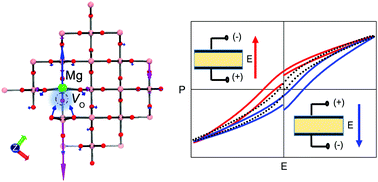Collective nonlinear electric polarization via defect-driven local symmetry breaking†
Abstract
In this work, we report the defect-mediated, abnormal non-linear polarization behavior observed in centrosymmetric rutile TiO2 where less than 1 at% of sterically mismatched Mg2+ ions are introduced to create ferroelectric-like polarization hysteresis loops. It is found that the  defect cluster produces a dipole moment exceeding 6 Debye, with a rotatable component. Such a polarization is further enhanced by the displacement of neighboring Ti4+ ions. The coupling between such defect-driven symmetry-breaking regions generates a collective nonlinear electrical polarization state that persists to high temperatures. More importantly, an observation of abnormal bias shift of polarization hysteresis suggests an antiparallel alignment of certain dipoles frozen relative to the external poling electric field, which is associated with oxygen vacancy hopping. This result challenges the long-standing notion of parallel alignment of dipoles with the external electric field in ferroelectrics. This work also reveals an unexpected new form of non-linear dielectric polarization (non-ferroelectricity) in solid-state materials.
defect cluster produces a dipole moment exceeding 6 Debye, with a rotatable component. Such a polarization is further enhanced by the displacement of neighboring Ti4+ ions. The coupling between such defect-driven symmetry-breaking regions generates a collective nonlinear electrical polarization state that persists to high temperatures. More importantly, an observation of abnormal bias shift of polarization hysteresis suggests an antiparallel alignment of certain dipoles frozen relative to the external poling electric field, which is associated with oxygen vacancy hopping. This result challenges the long-standing notion of parallel alignment of dipoles with the external electric field in ferroelectrics. This work also reveals an unexpected new form of non-linear dielectric polarization (non-ferroelectricity) in solid-state materials.



 Please wait while we load your content...
Please wait while we load your content...